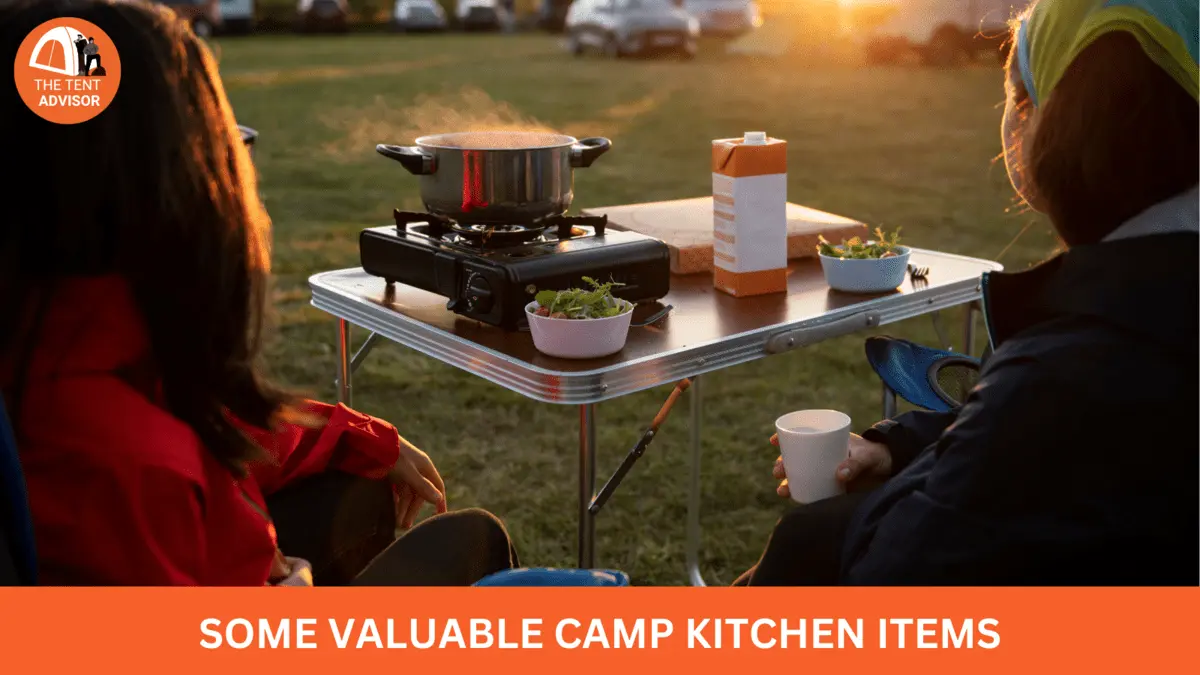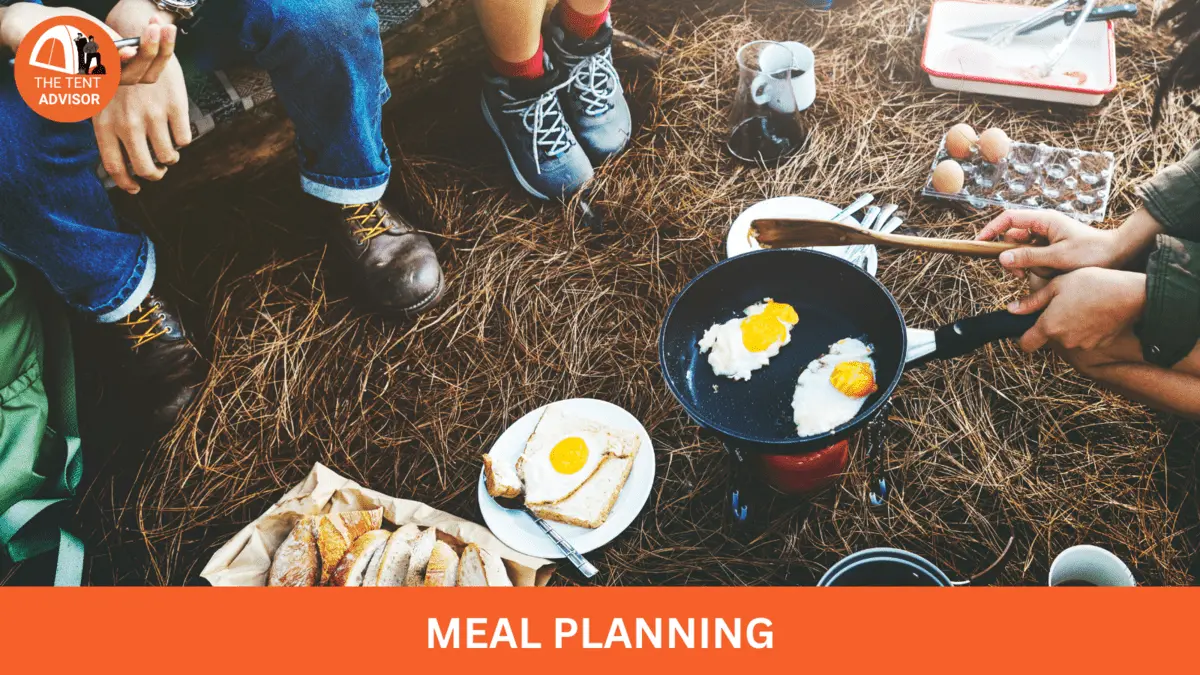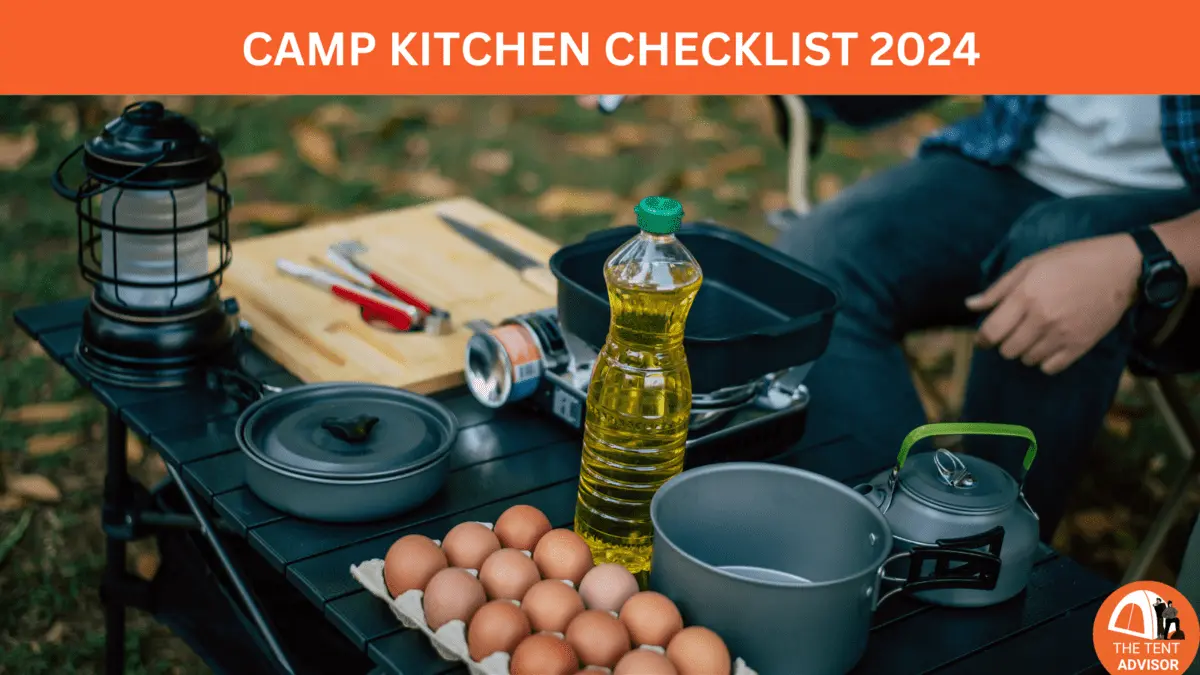If you are planning a camping trip, it is essential to know some important things before moving ahead.
Where you will stay, ensure you have carried your tent and, most importantly, all camp kitchen essentials.
All Your adventure outside will be successful only if you provide all available items and are well arranged in the camp kitchen. The worst thing can be to find yourself without essential cooking equipment or struggling to cook food outdoors.
To make packing easier and to avoid forgetting important stuff, keep a pre-packed bin with cooking essentials just for camping purposes. This Camp kitchen checklist includes everything from cooking materials and table setting up to storing and cleaning materials.
Remember that planning before your journey can help alleviate stress so you can focus on enjoying nature.
Ultimate Camping Kitchen Checklist: Essentials for Outdoor Cooking
Cooking and Prep:
- Camping stove and fuel
- Matches/lighter/fire starter
- Cook pot(s) and lid(s)
- Frying pan(s)
- Pot holders or pot clippers
- Spoon, flipper/spatula/tongs/whisk
- Bottle opener, can opener or multi-tool/corkscrew
- Sharp knife
- Cutting board
Optional:
- Camp grill with fuel
- Grill rack
- Griddle
- Dutch oven with lifter/lid remover
- 14.Charcoal/Briquettes
- 15.Firewood (found near campsite)
- Saw/Axe
- Tin foil
- Portable Coffee/Tea maker
- Bowls
- Measurements-Spoons
- Number of cups (measuring cups)
- Marshmallows/Roasting forks
- Turning the ice cream maker
- Hand-crank blender
- .camp table(s) or kitchen organizer unit
- Camp chairs
Setting the Camp Table:
- Plates/Mugs (one each)
- Cups/Water bottles (one each)
- Forks/knives/spoons
- Napkins
- Water bottles
- Tablecloth and clips
- Lantern/lighting
Camp Kitchen Storage:
- Cooler(s)
- Ice or ice substitutes
- Bear-proof food storage containers, rodent-proof food container
- Egg cartons 5.Small plastic food containers for leftovers
- Resealable bags
- Large bins/bags to carry/store kitchen stuff
Camp Kitchen Cleanup:
- Camp Sink / Washing Bins
- Big water jar that can be refilled
- Eco-friendly detergent
- Scrub brush/sponges
- Trash/Recycle bags
- Paper towels
- Dish drying rack
- Clothesline with clips for air-drying clothes
Common Camping Food Basics:
Salt & pepper Spices Cooking oil/non stick spray Coffee/tea/hot chocolate Sugar/Sugar substitute honey etc. Oatmeal Pancake mix Syrup Rice Dried pasta Canned foods (soup, chilli, etc.) Dried foods (fruit, jerky, etc.) Energy foods (bars, gels, trail mix) include peanut butter, jelly/jam, and marshmallows. (for roasting!)
List of some of the unusual yet most valuable items for Camp kitchen checklist

These items you may want to take along when planning for your camping kitchen:
Collapsible Sink or Wash Bin: Both these gadgets are great for washing dishes and cleaning up while saving water. They can be folded up and kept away until needed, thus saving space.
Reusable Spice Jars: Take a mini collection of these with you to accompany your outdoor meals. They may allow you to bring different spices along without taking up much room.
GSI Pot Scraper: This tool scrapes the last bits of food from pots and pans, helping reduce cleaning time and waste.
Silicone Cooking Utensils: Such spatulas and spoons made of silicone material are flexible, dishwasher safe, long-lasting besides that they do not harm pans or pots like metallic ones.
Jelly Roll Pans: Besides prepping work and baking, versatile jelly roll pans can also be used for grilling. These have accessible cleanability properties, plus they stack neatly and hence could serve various cooking tasks.
Fire-Starting Kit: A fire-starting kit is a must, and it includes waterproof matches, fire starter sticks, and a small fire steel in case one is trying to start a fire during wet conditions.
Portable Coffee/Tea Maker:
A compact coffee maker or tea infuser can go a long way if you love this kind of beverage during camping mornings.
Collapsible Colander and Bucket:
When not in use, these will collapse down to save space but will still be very suitable when one wants to wash vegetables, drain pasta or clean with them around
Rubber Jar Opener:
Surprisingly handy in any camp kitchen where hard-to-open jars are common occurrences
Corn Cob Holders:
If barbecuing corn on the cob is on your menu, then these simple tools allow you to safely handle the hot cobs without getting blistered fingers
Food Plate Covers/Screens: These are such a great deterrent against insects as they cover your food well particularly where there is a bug issue.
Pot Holders/Gloves: These come in handy when handling hot cookware, preventing burns on your hands while also making cooking over a campfire or on a camping stove safer.
For more information read out
Meal Planning

Meal planning is a crucial part of any camping trip because it helps you utilize resources optimally and ensure you have enough for delicious meals without stress. Here are some tips for effective meal planning.
Plan Ahead:
Before leaving home, decide what to eat. This will help you create a shopping list and ensure that all the necessary ingredients are within your reach.
Keep it Simple:
Instead of going for complex recipes, choose easy-to-prepare meals that require only a few cooking utensils. You can opt for one-pot dishes or foil-packet dinners.
Consider Shelf Life:
Choose perishable foods or those with a long shelf life. Canned goods, dried foods, and vacuum-sealed items are best for camping.
Prep at Home:
Try doing most of your prep work from home. Such activities include:
- Cutting vegetables.
- Marinating meats and separating ingredients into reusable containers.
- Saving you time and energy at the campsite.
When camping, you will be constrained in your cooking methods by your equipment and the resources at hand. The following are some of the most common outdoor meal-cooking methods:
Open-Fire Cooking:
Open-fire cooking using skillets, pots, or skewers made of cast iron can create a quintessential camping experience. Ensure that you follow all fire safety precautions and extinguish the fire completely afterwards.
Camp Stoves:
Portable camp stoves are convenient and efficient. They allow you to regulate temperatures and prepare several dishes simultaneously. For versatility, go for simple single-burner models or multi-burner ones.
Portable Grills:
Good for grilling meats like vegetables and pizzas. They can be set up easily and provide a very useful surface on which one can cook a variety of meals on-the-go. Depending on your grill type, use either charcoal or propane as fuel.
Recipe Ideas
Here are several easy recipes that you can make outside:
Foil Packet Meals: Mix diced potatoes, sliced vegetables, and protein like chicken or fish with seasonings in foil packet recipes to make them savorier. Cook over campfire coals wrapped in foil and enjoy a delicious, hassle-free meal.
Campfire Chili:
Take canned beans, tomatoes and pre-cooked meat to get yourself a hearty chili that is going to warm your heart during cold camping nights if simmered inside a pot upon an open fire or fireplace stove.
Grilled Skewers:
Thread chunks of meat and veggies on skewers, season them, and grill the kebabs either open-flame style or on portable grills as desired by each person; looking forward to instant customizability.
Oatmeal Packs:
Prepare instant oatmeal in a reusable container packed with hot water for a quick and healthful breakfast.
Packing and Organization
Efficient packing contributes significantly to smooth cooking while camping. The following tips will ensure that your camp kitchen is in order:
Use a Dedicated Bin:
Store all of your kitchen equipment in one container to make packing and unpacking easier.
Organize by Category:
Items should be separated into categories, such as cooking gear, table settings, and cleaning supplies. This will ensure that you remember everything and make it easy for you to find things when necessary.
Pack Efficiently:
Stackable containers and bags maximize space and eliminate clutter. Make sure sharp and delicate items are secure to avoid accidents or breakages.
Keep Essentials Accessible:
Store frequently used items at easily accessible points to facilitate meal preparation and cleanup activities.
For a memorable experience readout what is the rule no 1 for tent camping?
Yours Camp kitchen checklist is ready
Well-stocked camp kitchens can significantly affect the experience and quality of camping. Good meal planning, the choice of the correct cooking methods, and proper organization of your stuff will set you on a path to enjoyable outdoor cooking. Remember that the objective is to have a relaxing time in nature; therefore, some forethoughts can go a long way towards achieving this aim. Enjoy yourself while camping while preparing foodstuffs!
FAQs on Camp kitchen checklist
What four things should I take while going camping?
The following essential items must be considered;
Camping Tent: this is your overnight shelter, which must suit current weather patterns.
Sleeping Bag: Get warm during the night with them, and ensure their insulation matches climatic temperatures.
Warm Clothes; layered clothing, e.g., rain gear, including extra socks since the weather may change.
Food and Cooking Equipment: Bring enough food and cooking equipment for the trip, such as a portable stove, pots, and utensils.
What is the 5S checklist in a kitchen?
To organize and maintain an efficient workspace, you can use the 5S system. In a kitchen, it works in this way:
Sort: Pull out all unwanted items from necessary ones and clear off unwanted stuff.
Straighten: Arrange things systematically so they are easy to see and get.
Shine: Maintain your kitchen neatly to remain clean while cooking hygienically.
Standardize: Develop rules for organizing things in the kitchen and cleanliness standards.
Sustain: Perform regular reviews to ensure ongoing orderliness based on set guidelines or rules within the premises.
The above practices will help you achieve a camp kitchen that is well-organized and functional, thereby making camping enjoyable without any
. What foods are best to take camping?
When packing food for a camping trip, opt for items that are durable, easy to prepare, and can handle the outdoors. Here are some great choices:
- Fruits: Apples, pears, kiwis, and bananas are hardy and travel well. They provide a quick, healthy snack.
- Vegetables: Carrots, onions, and bell peppers are great for adding to meals and can be enjoyed raw or cooked.
- Proteins: Canned beans, dried meats, and pre-cooked sausages or bacon are excellent sources of protein that don’t require refrigeration.
- Grains: Instant rice, pasta, and oatmeal are easy to prepare and store.
- Snacks: Trail mix, granola bars, and crackers are convenient and provide energy.
Condiments and Seasonings: Bring small containers of salt, pepper, and your favourite spices to flavor your meals.
You also like to read
